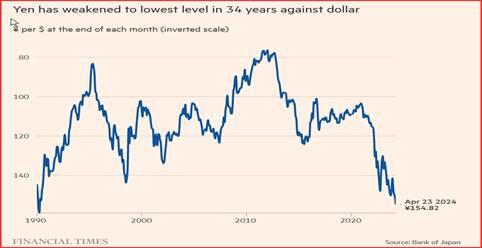Outlook
After the US close, it’s the Tokyo CPI, a reliable indicator of the national number and then the BoJ policy announcement. Tokyo CPI ex food and energy in Japan was a rise to 2.90% in March from 2.50%, and Trading Economics says the consensus forecast is 2.7% but it offers 2.7%. This looks like how many angels can dance but it’s a big deal in Japan after decades of deflation. The latest highest high is 155.75, the worst quote in three decades.
We dismissed yen intervention talk over the past few weeks, but the day of reckoning may well be upon us. See the chart from the FT. “Historic” levels don’t appear all that often but can have a big effect on sentiment, in this case, in Tokyo. Besides, Mr. Ueda seems to be a little different from the usual BoJ chief. Not too different, but perhaps more of a straight-shooter. You go long USD/JPY at your peril.
Forecast: We may tread water today. The most important data is tomorrow’s consumer income and spending with the accompanying PCE and core PCE. Headline PCE is forecast at 2.6% y/y (vs. CPI at 3.5%).
Remember that it was the March CPI that drove yields up in early April. The WSJ reports just ahead of CPI, the 10-year was 4.652%. Today it’s 4.65%, or no change. “Perhaps an upbeat report on Friday could boost optimism that the Fed might cut rates this year, and help send yields back down.” This now adds another voice to the FT and others pointing out that when you reduce the effect of shelter, inflation is not so bad, if with some sticky stuff.
We hesitate to say this possibility is driving anything, although it may be causing some position-adjustment. But the fact remains, the dollar is softer across the board (except the yuan). There are multiple triggers for the move, including renewed appetite for risk on stalemate in the Middle East, rising Bund yields, chatter about the US economy slowing while some Europeans are thriving, and so on—take your pick.
The outlook is binary. Favorable PCE = yield and dollar drop. Highish CPE = yields stay high, dollar recovers.
Reasons for the Fed to cut rates
Avoid embarrassment from getting inflation wrong twice.
Normalize the yield curve.
Head off any recessionary tendencies.
Help housing via mortgage rates.
Help banks rollover commercial property loans.
Help the stock market.
(Help the current White House).
PCE Watch: Conventional wisdom has PCE will rise a bit to 2.6% annualized on higher energy costs. Core is expected to rise 0.3% m/m, about the same as Feb (Bloomberg).
But as we have been writing, some nay-sayers are out in force. The FT, Yardeni and Truflation all indicate that if you modify the awful shelter contribution, which is lower in the PCE (15%) than in CPI (36%) anyway, actual inflation is close enough to the target to make a rate cut plausible. Now the WSJ adds a whisper that this is possible.
Bottom line, it’s still a minority opinion that inflation is not as bad as we think, and the minority view does not push yields. It’s yields and geopolitical uncertainty that are driving the dollar these days. Besides, the Fed does not fiddle with the data it is given, although it probably wishes it could. So, grain of salt.
This is an excerpt from “The Rockefeller Morning Briefing,” which is far larger (about 10 pages). The Briefing has been published every day for over 25 years and represents experienced analysis and insight. The report offers deep background and is not intended to guide FX trading. Rockefeller produces other reports (in spot and futures) for trading purposes.
To get a two-week trial of the full reports plus traders advice for only $3.95. Click here!
This morning FX briefing is an information service, not a trading system. All trade recommendations are included in the afternoon report.
Recommended Content
Editors’ Picks
EUR/USD clings to gains above 1.0750 after US data

EUR/USD manages to hold in positive territory above 1.0750 despite retreating from the fresh multi-week high it set above 1.0800 earlier in the day. The US Dollar struggles to find demand following the weaker-than-expected NFP data.
GBP/USD declines below 1.2550 following NFP-inspired upsurge

GBP/USD struggles to preserve its bullish momentum and trades below 1.2550 in the American session. Earlier in the day, the disappointing April jobs report from the US triggered a USD selloff and allowed the pair to reach multi-week highs above 1.2600.
Gold struggles to hold above $2,300 despite falling US yields

Gold stays on the back foot below $2,300 in the American session on Friday. The benchmark 10-year US Treasury bond yield stays in negative territory below 4.6% after weak US data but the improving risk mood doesn't allow XAU/USD to gain traction.
Bitcoin Weekly Forecast: Should you buy BTC here? Premium

Bitcoin (BTC) price shows signs of a potential reversal but lacks confirmation, which has divided the investor community into two – those who are buying the dips and those who are expecting a further correction.
Week ahead – BoE and RBA decisions headline a calm week

Bank of England meets on Thursday, unlikely to signal rate cuts. Reserve Bank of Australia could maintain a higher-for-longer stance. Elsewhere, Bank of Japan releases summary of opinions.
